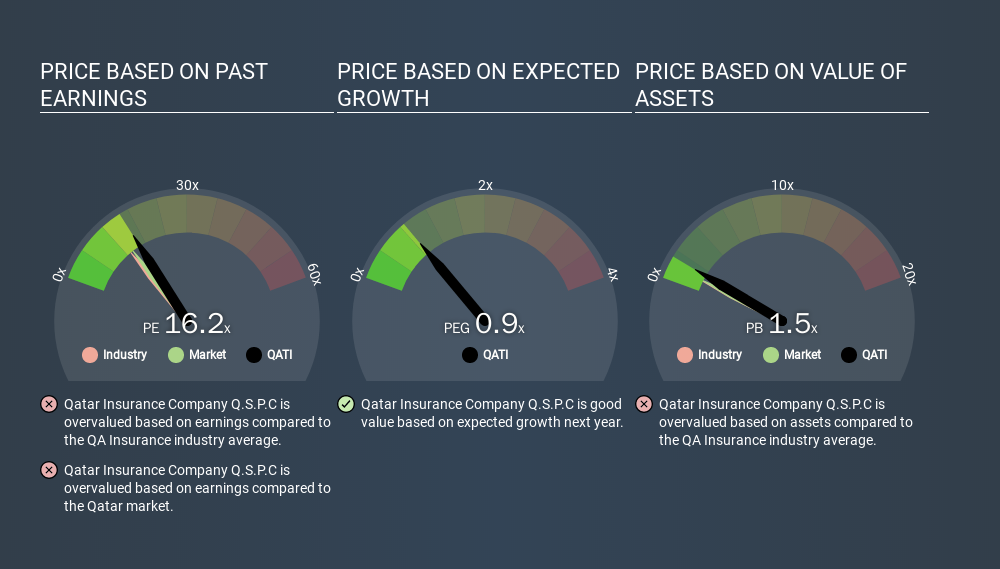Why Qatar Insurance Company Q.S.P.C.'s (DSM:QATI) High P/E Ratio Isn't Necessarily A Bad Thing
This article is for investors who would like to improve their understanding of price to earnings ratios (P/E ratios). We'll apply a basic P/E ratio analysis to Qatar Insurance Company Q.S.P.C.'s (DSM:QATI), to help you decide if the stock is worth further research. What is Qatar Insurance Company Q.S.P.C's P/E ratio? Well, based on the last twelve months it is 16.21. In other words, at today's prices, investors are paying QAR16.21 for every QAR1 in prior year profit.
View our latest analysis for Qatar Insurance Company Q.S.P.C
How Do I Calculate Qatar Insurance Company Q.S.P.C's Price To Earnings Ratio?
The formula for P/E is:
Price to Earnings Ratio = Share Price ÷ Earnings per Share (EPS)
Or for Qatar Insurance Company Q.S.P.C:
P/E of 16.21 = QAR3.18 ÷ QAR0.20 (Based on the year to September 2019.)
Is A High Price-to-Earnings Ratio Good?
A higher P/E ratio means that investors are paying a higher price for each QAR1 of company earnings. That is not a good or a bad thing per se, but a high P/E does imply buyers are optimistic about the future.
How Does Qatar Insurance Company Q.S.P.C's P/E Ratio Compare To Its Peers?
We can get an indication of market expectations by looking at the P/E ratio. You can see in the image below that the average P/E (12.9) for companies in the insurance industry is lower than Qatar Insurance Company Q.S.P.C's P/E.

That means that the market expects Qatar Insurance Company Q.S.P.C will outperform other companies in its industry. The market is optimistic about the future, but that doesn't guarantee future growth. So further research is always essential. I often monitor director buying and selling.
How Growth Rates Impact P/E Ratios
Companies that shrink earnings per share quickly will rapidly decrease the 'E' in the equation. That means even if the current P/E is low, it will increase over time if the share price stays flat. A higher P/E should indicate the stock is expensive relative to others -- and that may encourage shareholders to sell.
Qatar Insurance Company Q.S.P.C increased earnings per share by a whopping 45% last year. Unfortunately, earnings per share are down 13% a year, over 5 years.
Remember: P/E Ratios Don't Consider The Balance Sheet
One drawback of using a P/E ratio is that it considers market capitalization, but not the balance sheet. Thus, the metric does not reflect cash or debt held by the company. Hypothetically, a company could reduce its future P/E ratio by spending its cash (or taking on debt) to achieve higher earnings.
While growth expenditure doesn't always pay off, the point is that it is a good option to have; but one that the P/E ratio ignores.
Is Debt Impacting Qatar Insurance Company Q.S.P.C's P/E?
With net cash of ر.ق3.6b, Qatar Insurance Company Q.S.P.C has a very strong balance sheet, which may be important for its business. Having said that, at 34% of its market capitalization the cash hoard would contribute towards a higher P/E ratio.
The Verdict On Qatar Insurance Company Q.S.P.C's P/E Ratio
Qatar Insurance Company Q.S.P.C's P/E is 16.2 which is above average (14.0) in its market. The excess cash it carries is the gravy on top its fast EPS growth. To us, this is the sort of company that we would expect to carry an above average price tag (relative to earnings).
Investors should be looking to buy stocks that the market is wrong about. As value investor Benjamin Graham famously said, 'In the short run, the market is a voting machine but in the long run, it is a weighing machine. So this free visual report on analyst forecasts could hold the key to an excellent investment decision.
Of course, you might find a fantastic investment by looking at a few good candidates. So take a peek at this free list of companies with modest (or no) debt, trading on a P/E below 20.
If you spot an error that warrants correction, please contact the editor at editorial-team@simplywallst.com. This article by Simply Wall St is general in nature. It does not constitute a recommendation to buy or sell any stock, and does not take account of your objectives, or your financial situation. Simply Wall St has no position in the stocks mentioned.
We aim to bring you long-term focused research analysis driven by fundamental data. Note that our analysis may not factor in the latest price-sensitive company announcements or qualitative material. Thank you for reading.
About DSM:QATI
Qatar Insurance Company Q.S.P.C
Engages in the insurance, reinsurance, real estate asset management, and information technology businesses.
Adequate balance sheet with acceptable track record.
Market Insights
Weekly Picks

THE KINGDOM OF BROWN GOODS: WHY MGPI IS BEING CRUSHED BY INVENTORY & PRIMED FOR RESURRECTION


Why Vertical Aerospace (NYSE: EVTL) is Worth Possibly Over 13x its Current Price


The Quiet Giant That Became AI’s Power Grid
Recently Updated Narratives


A case for USD $14.81 per share based on book value. Be warned, this is a micro-cap dependent on a single mine.

Occidental Petroleum to Become Fairly Priced at $68.29 According to Future Projections

Agfa-Gevaert is a digital and materials turnaround opportunity, with growth potential in ZIRFON, but carrying legacy risks.
Popular Narratives


MicroVision will explode future revenue by 380.37% with a vision towards success


Crazy Undervalued 42 Baggers Silver Play (Active & Running Mine)





